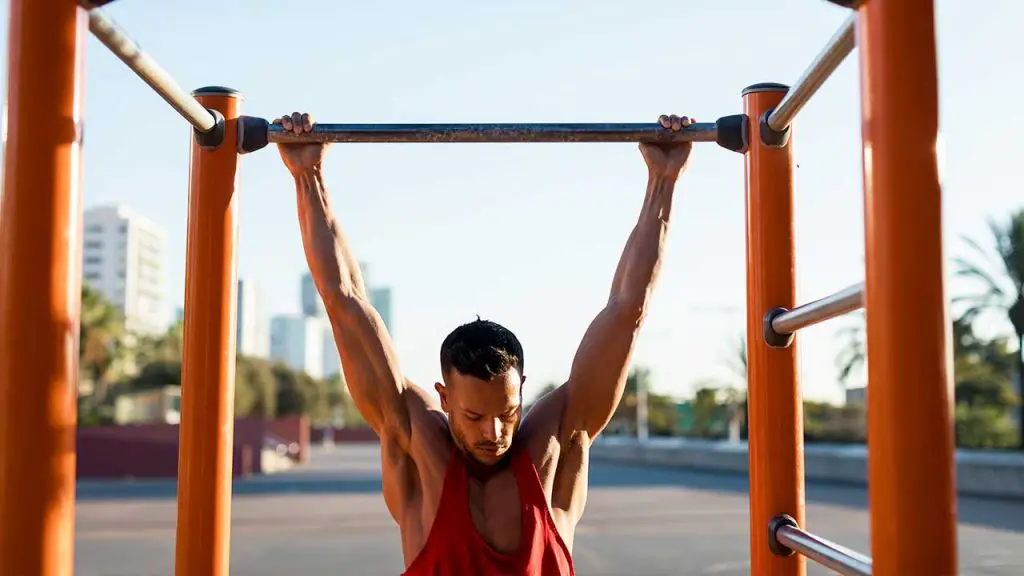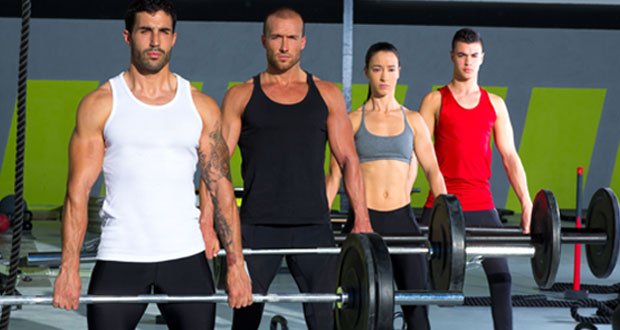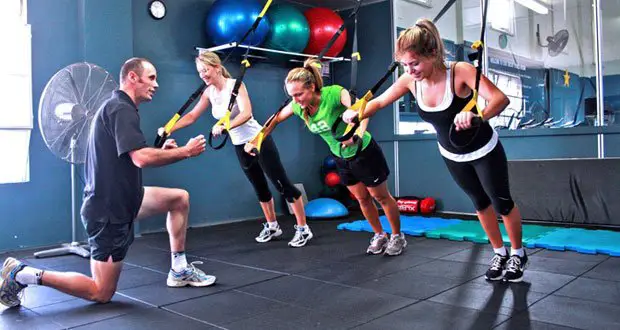How Many Pull Ups is Good? A Clear Guide for Fitness Enthusiasts

ListedFit is reader-supported. When you buy through links on our site, we may earn a small commission.
Pull-ups are a popular and effective upper body exercise that targets multiple muscle groups, including the back, shoulders, and arms. The number of pull-ups one can do is often considered a benchmark of their fitness and strength.
However, determining how many pull-ups are considered good varies based on factors such as experience, gender, body weight, and age.
For example, fit and active men should aim to perform at least 8 pull-ups per set, while for a woman 2-5 in a single set is considered good.
Those who can consistently do more than 12 to 15 pull-ups for men and 3 for women are in the highest percentile and regarded as exceptionally strong.
Regardless of your current capability, it’s important to focus on improving your technique and gradually building your endurance.
Key Takeaways
- The number of pull-ups considered good varies based on experience, gender, body weight, and age.
- Fit and active men should aim for at least 8 pull-ups, while women should strive for 2 to 5 in a single set.
- Consistently doing more than 12 to 15 pull-ups for men and 2 to 5 for women is a good target.
Table of Contents
How Many Pull-Ups is Good?

Determining how many pull-ups are considered “good” depends on factors such as body weight, age, gender, and fitness level. However, some general guidelines can help you assess your pull-up performance and set realistic goals for improvement.
For fit and active men, doing at least 4 to 8 pull-ups in one set is a solid benchmark. If you can perform 12 to 15 pull-ups or more with good form, you are in the highest percentile for pull-up ability. For fit and active women, achieving 2 to 5 pull-ups in one set is commendable. Performing more than three pull-ups is considered very good for women.
Experience level will impact your pull-up performance. After about 2 years of consistent training, you should be able to achieve the average number of pull-ups for the intermediate category based on your gender, weight, and age.
In terms of fitness standards, men should be able to perform 8 pull-ups, with 13-17 reps considered fit and strong. Women should aim for 1-3 pull-ups, while 5-9 reps are considered fit and strong for them.
Taking these factors into consideration, you can set realistic goals for your pull-up performance.
Incorporating other strength training exercises and adopting a balanced diet can contribute to improving your overall fitness level and pull-up abilities.
How Many Pull-Ups Can the Average Woman Do?

When discussing the number of pull-ups an average woman can do, it is essential to consider factors such as experience level, gender, body weight, and age. These factors play a significant role in determining each individual’s ability to perform pull-ups.
As a general guideline, with consistent training, the average woman can do about 5-6 pull-ups after two years of training. However, bear in mind that numbers may vary from person to person due to the factors mentioned above.
For instance, when looking at age as a factor, women in different age groups could perform different numbers of pull-ups on average. By training consistently, most women of various ages can achieve a range of 15-25 pull-ups. This number would depend on their dedication and intensity of training.
In terms of fitness standards, if you can do more than 3 pull-ups as a woman, you are considered to perform at a good level. Achieving 12 to 15 pull-ups or more with good form places you in the highest percentile, meaning you are performing exceptionally well.
Remember, do not compare yourself to others, but focus on your personal progress and improvement. As long as you continue to train consistently and challenge yourself, your pull-up skills will develop, and you will eventually reach your desired performance level.
Techniques to Improve Your Pull-Ups
Incorporating Resistance Training
Resistance training is essential for increasing your pull-up abilities. By focusing on the prime movers involved in the pull-up, you can develop the strength and muscle endurance necessary for this demanding exercise. The core, biceps, lats, and mid- and lower-traps are the key muscles to work on. Incorporate resistance bands or use a weight belt to add load to your pull-ups, challenging your muscles and promoting growth.
Combining Pull-Ups With Other Exercises
To further improve your pull-up skills, combine pull-ups with other back exercises in your workout routine. A diverse range of exercises will ensure that you target various muscle groups needed for pull-ups. Include exercises like lat pulldowns, close grip lat pulldowns and dead hang to strengthen and stretch your back muscles. Also, consider incorporating other compound exercises like rows and chin-ups for a well-rounded training programme.
Optimal Set and Repetition Patterns
The ideal training frequency and tempo for pull-ups can vary depending on your fitness level and expertise in the movement. For beginners, start with a lower volume of pull-ups, like performing 2-3 sets of 5 repetitions with adequate rest in between. As for more advanced pull-up practitioners, increase the volume and intensity by performing 4-5 sets of 10-12 repetitions to push your muscles to their limit.
Remember to perform negatives and use a spotter if needed to help you maintain your form and decrease the risk of injury. Also, consume a higher-protein diet to aid in muscle recovery and growth. Experiment with different combinations of sets and reps, rest intervals, and techniques as you progress in your pull-up journey to find what works best for you and your specific goals.
Keep these tips in mind, and soon you’ll notice significant improvements in your pull-up performance, helping you reach new heights in your fitness endeavours. Remember to remain consistent, patient and focused on your goals, and you will see progress.
Special Considerations for Pull Ups
Gender Differences in Pull Ups
When discussing pull ups, it’s important to consider the differences between men and women. Generally, fit and active women should be able to do at least 2 to 5 pull-ups in one set, while men should aim for around 8. This is due to differences in upper body strength, as men tend to have more muscle mass in this area. However, achieving higher numbers of pull-ups for both genders can place you in the highest percentile of fitness.
Age and Pull Ups
Age can impact your ability to perform pull-ups, as well as the number you should aim for. While specific age brackets aren’t provided in the search results, it’s important to maintain realistic expectations and adjust your goals based on your experience level. For example, after 2 years of consistent training, you should be able to achieve an average number of pull-ups for your gender, weight, and age.
Using Assisted Pull Ups
If you’re a beginner or struggling to perform full pull-ups, consider incorporating assisted pull-ups into your workout routine. Assisted pull-ups can help you develop the necessary strength and endurance in your upper body, core, and back muscles to move towards performing unassisted pull-ups. This can be achieved by using a resistance band, an assisted pull-up machine, or even a workout partner for support. As you become stronger, gradually decrease the amount of assistance provided until you can perform full pull-ups independently.
Remember to consult your doctor before undertaking any new fitness regimen, and always ensure you perform exercises with proper form to avoid injuries. Consistency in your workouts, along with paying attention to your body’s feedback, is key to building your pull-up abilities over time.
How Many Chin Ups is Good?

Achieving a good number of chin-ups depends on your individual fitness level, goals, and body composition. While there isn’t a one-size-fits-all answer, there are some general guidelines to help you determine how many chin-ups you should be able to do.
For men, being able to perform at least 8 chin-ups is a good starting point, while 13-17 chin-ups is considered fit and strong. On the other hand, women should aim for 1-3 chin-ups initially. If a woman is able to achieve 5-9 chin-ups, she is considered fit and strong in this exercise.
It is essential to focus on gradual improvement. As you progress in your fitness journey, you can set new targets. Once you’re able to do 12-15 chin-ups with relative ease, consider incorporating multiple sets with 10 reps each into your workout routine. Start with two sets of 10 reps, and in the following weeks, you can increase to three, four or even five sets. This will help with building muscle, improving strength, and maintaining progress.
Of course, it’s worth considering that the average male lifter can perform around 14 chin-ups. This figure may serve as a benchmark and motivation to push beyond what is deemed ‘average’ for your gender. But remember that everyone’s fitness journey is unique, and comparing yourself with others should not be the ultimate goal.
There is no definitive answer to how many chin-ups are good, as individuals have varying fitness levels and goals.
However, by considering the general guidelines and setting realistic targets, you can continuously challenge and improve your chin-up performance. Prioritise form, technique, and gradual progress, as these elements will contribute to achieving the best results.
Pull Up Records and Achievements
When it comes to pull-ups, there are some truly astonishing achievements by elite athletes in both the male and female categories.
For fit and active men, the goal typically ranges from 8 to 15 pull-ups. Highly trained individuals can achieve 12 to 15 repetitions, placing them in the highest percentile of male fitness levels. On the other hand, fit and active women should aim for 2 to 5 pull-ups, with anything above 3 considered very good.
These numbers are just basic guidelines and can vary depending on factors such as your weight, physique, and overall strength levels.
The world record for the most pull-ups in three minutes was recently set by Wang Xincheng, a university student in Beijing, China, who managed to complete an astounding 112 pull-ups.
For those looking to improve their endurance beyond the average man or woman, additional equipment such as a weight belt can be incorporated to increase difficulty and build a bigger, stronger back.
With consistent training and challenging yourself, you will increase your pull-up performance significantly.
In terms of specific achievements and guidelines, the United States Marine Corps (USMC) uses pull-ups as a key component of its Physical Fitness Test (PFT) to measure the strength and endurance of its military personnel.
For male servicemembers, the perfect score requires a minimum of 23 pull-ups, while female servicemembers must complete a minimum of 10 pull-ups for their perfect score. These numbers reflect the high level of physical fitness expected within the military ranks.
Keep in mind that the number of pull-ups one can achieve varies greatly depending on one’s gender, physical fitness, and training background.
While the records set by elite athletes may be out of reach for the average person, there’s always room for improvement, and setting goals with your training is very useful and can lead to outstanding achievements.
Frequently Asked Questions
Should I do chin-ups or pull-ups?
It ultimately depends on your training goals and personal preferences. Chin-ups emphasize your biceps more, while pull-ups target your back muscles, mainly the latissimus dorsi.
You can incorporate both exercises into your routine to balance your muscle development and ensure proper strength progression.
What is the average number of pull-ups?
The average number of pull-ups varies depending on factors such as age, gender, and fitness level.
For men, performing more than 8 pull-ups is considered very good, while for women, more than 3 pull-ups is impressive.
With consistent training, you may reach up to 12-15 pull-ups with good form, placing you in the highest percentile.
How many pull-ups should beginners do each day?
As a beginner, it’s essential to establish a solid foundation and gradually progress. Start with one or two sets of as many repetitions as you can perform with proper form.
Focus on improving your technique and increasing your repetitions over time. Remember that rest days are crucial for growth and recovery, so avoid doing pull-ups every day.
What is the recommended number of pull-ups for building muscle?
To build muscle effectively, you can use the progressive overload principle by increasing the number of pull-ups, adding weight, or varying the tempo.
A good starting point is to perform 3-4 sets of 6-12 repetitions, with 1-2 minutes of rest between each set. This training range suits hypertrophy-focused training.
What is a good number of pull-ups based on age?
An average number of pull-ups by age ranges from a few to several, with younger individuals generally being capable of more due to increased strength and muscle mass.
However, these numbers can vary widely based on factors such as individual fitness levels and genetics.
Can the average person do 15-20 pull-ups in a row?
Performing 15-20 pull-ups in a row is a challenging feat, even for experienced athletes. The average person may not be able to achieve this without consistent and focused training.
It’s essential to set reasonable goals and work on increasing your pull-up numbers progressively.
How do Navy SEALs perform in terms of pull-ups?
Navy SEALs are well-known for their exceptional physical abilities. While there isn’t a specific number of pull-ups that all SEALs can perform, they usually have to meet rigorous physical fitness standards.
These standards might include completing numerous pull-ups during training and evaluations to demonstrate superior upper body strength and endurance.
Author
- Danny Loeb is a qualified Personal Trainer, Fitness Model and Writer. He enjoys blogging about health and fitness, messing around with Photoshop, and sharing his experiences with everyone.
Latest entries
 NutritionFebruary 6, 2024What Are Fillers in Supplements? – Unveiling Inactive Ingredients
NutritionFebruary 6, 2024What Are Fillers in Supplements? – Unveiling Inactive Ingredients FitnessAugust 23, 2023Best Post-Workout Foods: Great Ideas for Recovery and Results
FitnessAugust 23, 2023Best Post-Workout Foods: Great Ideas for Recovery and Results BulkingJuly 26, 2023Is Rice Good for Bulking? Unveiling the Truth
BulkingJuly 26, 2023Is Rice Good for Bulking? Unveiling the Truth CultureJuly 15, 2023Why Do People Hate Planet Fitness? Read This Before You Join!
CultureJuly 15, 2023Why Do People Hate Planet Fitness? Read This Before You Join!
Affiliates:
This post may contain affiliate links that at no additional cost to you, the site may earn a small commission. We only recommend products we would use ourselves and all opinions expressed on this site are our own.
General Advice:
The information provided in this article is for general informational purposes only. It is not intended as a substitute for professional advice. Always consult with a qualified healthcare professional before starting any new diet, exercise program, or making changes to your health routine.
Accuracy Advice:
While we strive to provide up-to-date and accurate information, the content in this article may not reflect the most current research or medical guidelines. We encourage readers to do further research and consult with professionals for more personalized advice.
Our Recommendations:
The products and services mentioned in any of our articles are recommended based on our independent research and personal experience. We are not sponsored by any company. We aim to suggest products and services we believe are of high quality and could be beneficial to our readers.






